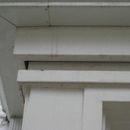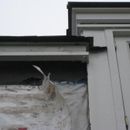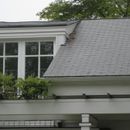Where is the water coming from?
I am working on a house about 30 miles north of NYC. It has had a paint peeling problem for 15-20 years, ever since the house was renovated. It has many large thermopane windows, all with copper pans below. It has a narrow continuios vent at the fascia, no soffit, and a 41/2″ pitched roof over the windows that extends to the ridge. the rest of the roof is a 6 1/2″ pitch with the same venting detail. there is a continuios ridge vent. It is sided with 3/4″ x 10″ redwood clapboard siding that was back primed with a 2 1/2″ overlap over Tyvek and Barricade wrap around window openings . I removed the siding in one section to try to determine why the siding was getting so wet.. What I found is the CDX sheathing wet. There did not appear to be any signs of water getting in from the vents. the moisture appeared to be originating from behind the Barricade material that wrapped the rough openings. I can see that the moisture needs a way to escape, but I don’t understand where this moisture is coming from. Any thoughts
Jim
GBA Detail Library
A collection of one thousand construction details organized by climate and house part













Replies
James,
It's impossible to answer your questions over the Internet. Possible ways that water could be reaching the housewrap include:
1. Wind-driven rain is getting past the siding. (This is very common; in fact, it is to be expected.)
2. Ice dams cause water to enter the top of the wall and dribble down the housewrap.
3. The wall assembly doesn't have a good air barrier, and warm humid interior air is migrating through the wall assembly, allowing moisture to condense at the cold sheathing during the winter.
I understand it is impossible to answer over the internet but what I was hoping to get some other insights on why it seams to have more moisture under the Barricade material that is near the window casings then in the middle of the field. Also I would think that I would see some evidence of water getting in, or at least evidence of previous water higher up on the CDX sheathing. It is possible for the water to be trapped if it were to dribble in from above because the siding is had been caulked at the lap joint.. It's the warm humid air that has me wondering, would there have to be high humidity in the house to cause this? Would the fact that the eave vents are smaller than the ridge vent be enough to cause wall wetting? There also are non IC HI Hats installed in the attic and cathedral ceilings.
James,
I think it is highly unlikely that this home's soffit vents and ridge vents have anything to do with the problem with the plywood wall sheathing. If there is a roof-venting problem, the symptoms usually show up on the underside of the roof sheathing, not at the wall sheathing.
To diagnose the source of the moisture requires a sharp set of eyes and the use of diagnostic equipment. A blower door will tell you how leaky the building is. A hygrometer will tell you the indoor relative humidity. Careful observation of the location of wet spots will give you clues about the source of the water.
My guess is that these symptoms will be alleviated if you can:
1. Tighten up air leakage through the wall.
2. Install a new WRB (housewrap or asphalt felt).
3. Install a ventilated air gap (a rainscreen gap) between the siding and the WRB. You can achieve this with vertical furring strips or a product like Cedar Breather.
Good luck.
Jim,
I think the water originated from the exterior and was either going straight through the housewrap or sneaking around it starting from the joint between the window trim and the siding.
You state that the paint has been peeling which could be evidence of water on the back side of the siding. This is expected but perhaps your particular project had a higher than average amount or for whatever reason was not able to drain out easily. Given the complex geometry of the roof it may also be possible that a large volume of water was running over the trim/siding joint whenever it rained and that some of this water was sucked in behind the siding. In any case, the water likely came from the outside and made its way to the back side of the siding.
The housewrap was installed +/- 15 years ago, well before the wood surfactants/housewrap problems were solved. From the photos it appears that the siding had been tight to the wrap. Those two things may have contributed to compromised (i.e.- poorly performing) housewrap. Or, there may just have been a tear or a nail in an unfortunate location (more likely, BTW). Either case, it's not crazy to think the water that made its way to the back side of the siding then went straight through the housewrap.
Or it may have gone around edge of the housewrap. The photos show the housewrap stopping short of the window trim, so, at that location you've got a possible concentration of exterior water and a nice joint for it to either fall into or get sucked into. Once it's made it to the outside surface of the window wrap its very possible it got sucked along the surface, behind the housewrap until it reached the OSB.
Unless the homeowner has a greenhouse or an overheated Swim-X in the room behind that wall I think its extremely unlikely the water came from inside. Usually, the most likely cause is the actual cause and in your case its probably just rain making its way inside from a hole within a foot or two of the observed wet spot.
There is not a greenhouse but there is a indoor pool at the far end of the house (opposite end). It does not have any other connection to the house other than a door which is kept closed all the time. I don't know what temp it is kept at.There also is one month in the summer when the house is closed up and the AC is set to 88 degrees. Would a 1/8" vertical furring strip be enough of a air gap behind the siding?
OK, here's a scenario to check out. Suppose that indoor pool is covered by a roof, with attic space open to the attic space over the rest of the house. Suppose, too, that through numerous leaks in the ceiling above the pool the attic space is very humid all the time, to the point where there is regular condensation under the roof deck, and the wetness is wicking down to the soffit area, then down the sheathing. James, have you gone into the attic to check for this?
A 1/8" furring strip, while enough to permit some drainage of water from behind the siding, isn't really enough of a gap, as a water droplet can bridge that gap. You'd need at least around 1/4" gap, and more just improves the drying capability. It's interesting that the Benjamin Obdyke product "Homeslicker" comes in two thicknesses, 7 and 10 mm (roughly 1/4" and 3/8"). Canadian standards for areas that require rainscreen call for a 10 mm minimum. Many builders just use 1x (3/4") for furring.
Expensive home, indoor pool, moisture problems, time to call Building Science Corp. They are the experts.
The pool roof is not attached to any other roof. it is a flat roof that buts into a side wall that has no paint peeling issue. The wall the pool abuts is a bearing wall with a cathedral ceiling which is perpendicular to the rest of the house. I have gone in the attic and could not see close enough to the wall. I did send a camera up the eave and could see what looks like the start of plywood delaminating.I suspect the roof deck was covered with ice and water before it was re roofed.
The reason I was asking about 1/8" strips was to preserve the exterior trim, but I think thats not going to be possible with anything thicker.